wheel alignment FORD FIESTA 2007 Workshop Manual
[x] Cancel search | Manufacturer: FORD, Model Year: 2007, Model line: FIESTA, Model: FORD FIESTA 2007Pages: 1226, PDF Size: 61.26 MB
Page 82 of 1226
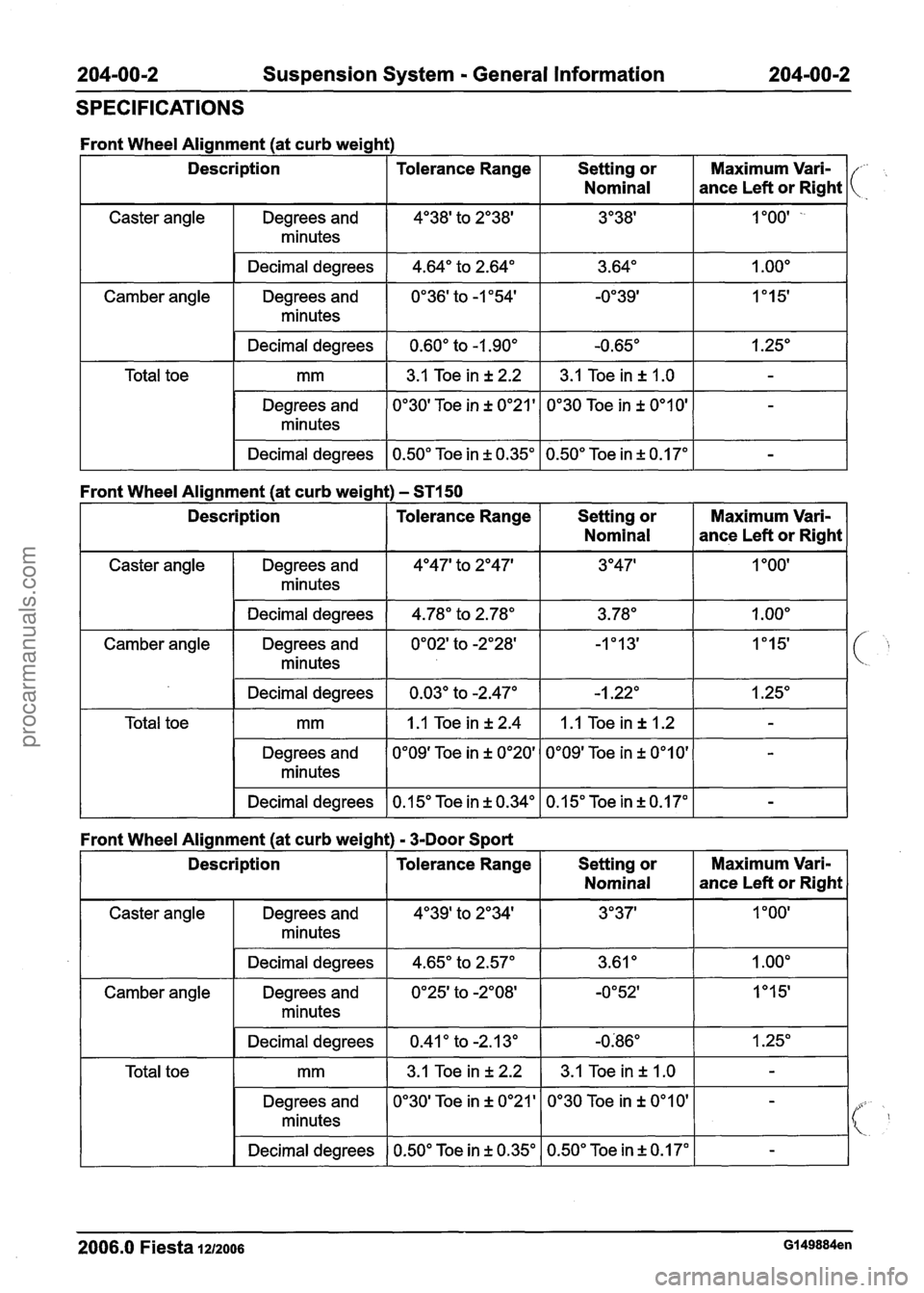
204-00-2 Suspension System - General Information 204-00-2
SPECIFICATIONS
Caster angle
Front Wheel Alignment (at curb weight)
Degrees and / 4'38'to 2'38' 1
minutes
Maximum Vari-
ance Left or Right
Description
I Camber angle I Degrees
and 1 0°36'to -1'54' 1 -0'39' I 1'15'
Decimal degrees
Tolerance Range
Setting or
Nominal
4.64" to 2.64"
Total toe
Degrees and minutes
Front Wheel Alignment (at curb weigh
Description
3.64"
minutes
Decimal degrees mm
Decimal degrees
Tolerance Range Setting or
I Nominal
1 .OOO
Maximum Vari-
ance Left or Right
0.60" to -1 .90°
3.1Toeink2.2
- 0'30' Toe in k 0'21'
0.50" Toe in k 0.35"
Caster angle
0'30 Toe in + 0°1 0'
Degrees and minutes -0.65"
3.1Toeink1.0
0.50"
Toe in k 0.1 7"
Decimal degrees
1.25"
-
-
Camber angle Degrees and
minutes
Decimal degrees
Total toe
Degrees and
minutes
0°09' Toe in k 0°20' 1 0°09' Toe in k 0°10'
Decimal degrees 0.15" Toe in k 0.34" ( 0.15" Toe in k 0.1 7"
Caster
angle
Front Wheel Alignment (at curb weight) - %Door Sport
Description
Camber angle
Degrees and minutes
Decimal degrees Degrees and
1 0'25' to -2'08' 1 -0'52'
minutes
Decimaldegrees
1 0.4I0to-2.13" 1 -0:86"
Maximum Vari-
ance Left or Right
Tolerance Range
4'39' to 2'34'
4.65"
to 2.57"
Total toe
Setting or
Nominal
Degrees and 0'30' Toe in k 0'21' 0'30 Toe in k 0°10'
minutes
3"37'
3.61"
I Decimal degrees 1 0.50" Toe in k 0.35" 1 0.50" Toe in k 0.17" 1 - I
1°00'
1
.OOO
2006.0 Fiesta 1212006 G149884en
procarmanuals.com
Page 84 of 1226
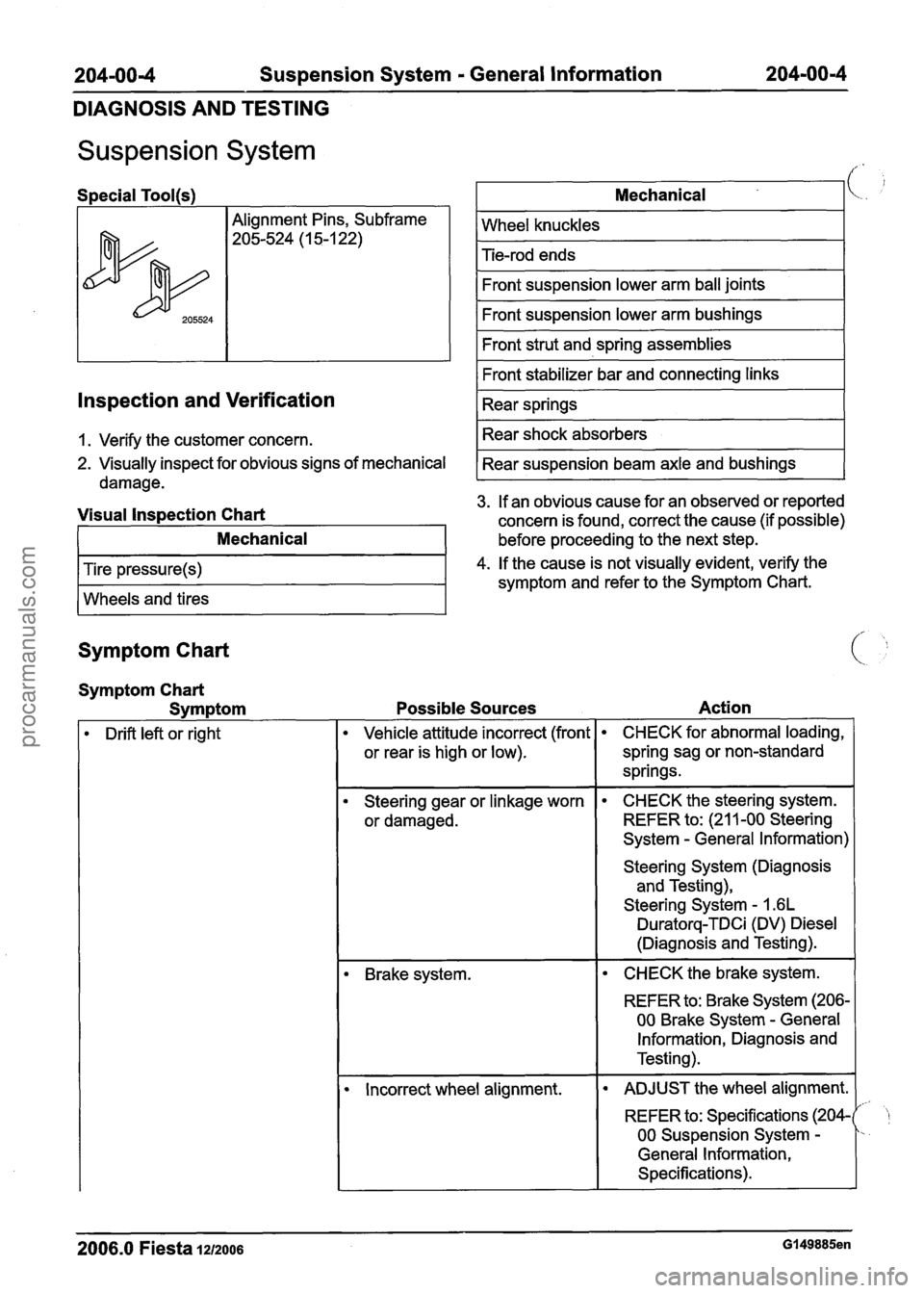
204-00-4 Suspension System - General Information 204-00-4
DIAGNOSIS AND TESTING
Suspension System
I I Alignment Pins, Subframe I
lnspection and Verification
Mechanical
Wheel knuckles
Tie-rod ends
Front suspension lower arm ball joints
Front suspension lower arm bushings
Front strut and spring assemblies
Front stabilizer bar and connecting links
Rear springs
Rear shock absorbers
Rear suspension beam axle and bushings
1.
Verify the customer concern.
I
2. Visually inspect for obvious signs of mechanical
damage.
3. If an obvious cause for an observed or reported Visual Inspection Chart concern is found, correct the cause (if possible)
I I Wheels and tires
Mechanical
Tire pressure(s)
Symptom Chart
before proceeding to the next step.
4. If the cause is not visually evident, verify the
symptom and refer to the Symptom Chart.
Symptom Chart
Symptom
Drift left or right
Possible Sources Action
Steering System (Diagnosis
and Testing),
Steering System
- 1.6L
Duratorq-TDCi (DV) Diesel
(Diagnosis and Testing).
Vehicle attitude incorrect (front
or rear is high or low).
Steering gear or linkage worn
or damaged.
I Brake system. I CHECK the brake system. I
CHECK for abnormal loading,
spring sag or non-standard
springs.
CHECK the steering system.
REFER to: (21 1-00 Steering
System
- General Information)
REFER to: Brake System (206-
00 Brake System
- General
Information, Diagnosis and
REFER to: Specifications (204-
'!
00 Suspension System -
i
General Information,
Specifications).
Incorrect wheel alignment.
2006.0 Fiesta 1212006 GI 49885en
Testing).
ADJUST the wheel alignment. ,'-
procarmanuals.com
Page 85 of 1226
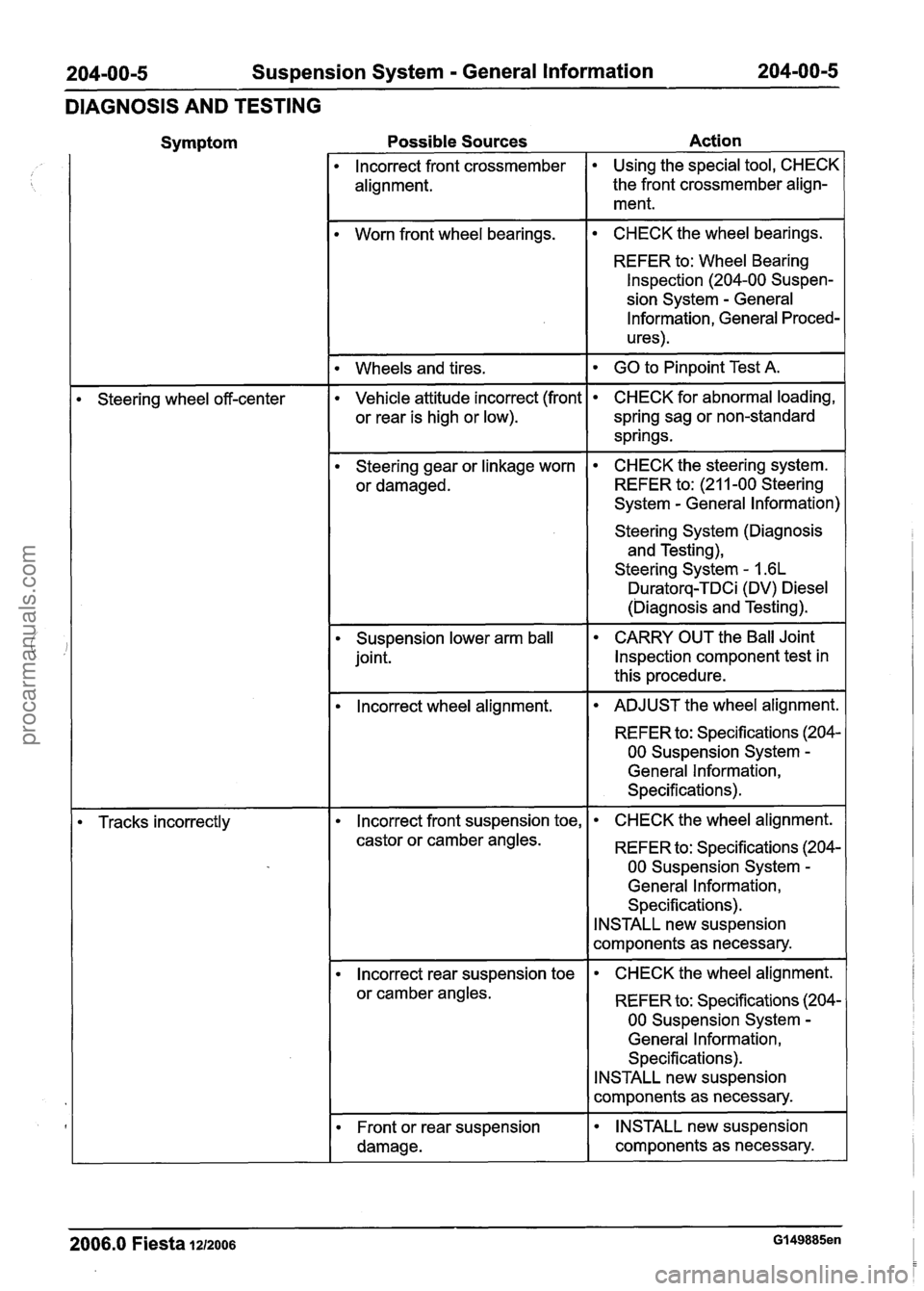
204-00-5 Suspension System - General Information 204-00-5 --
DIAGNOSIS AND TESTING
Symptom Possible
Sources -
l ncorrect front crossmem ber
alignment.
Action
Using the special tool, CHECK
the front crossmember align- ment.
Worn front wheel bearings. CHECK
the wheel bearings.
REFER to: Wheel Bearing
lnspection (204-00 Suspen-
sion System
- General
Information, General Proced-
ures).
I Wheels and tires. I . GO to Pinpoint Test A. I
Steering wheel off-center Vehicle attitude incorrect (front
or rear is high or low).
Tracks incorrectly CHECK for abnormal loading,
spring sag or non-standard
springs.
-
Steering gear or linkage worn
or damaged. CHECK the steering system.
REFER to: (21 1-00 Steering
System
- General Information)
Steering System (Diagnosis and Testing),
Steering System
- 1.6L
Duratorq-TDCi (DV) Diesel
(Diagnosis and Testing).
Suspension lower arm ball
joint. CARRY
OUT the Ball Joint
lnspection component test in
this procedure.
lncorrect wheel alignment. ADJUST
the wheel alignment.
REFER to: Specifications (204-
00 Suspension System
-
General Information,
Specifications).
lncorrect front suspension toe,
castor or camber angles. CHECK
the wheel alignment.
REFER to: Specifications (204-
00 Suspension System
-
General Information,
Specifications).
INSTALL new suspension
components as necessary.
~ncorrecGar suspension toe
or camber angles. CHECK
the wheel alignment.
REFER to: Specifications (204-
00 Suspension System
-
General Information,
Specifications).
INSTALL new suspension
components as necessary.
2006.0 Fiesta 1212006 Gl49885en
Front or rear suspension
damage. INSTALL new
suspension
components as necessary.
procarmanuals.com
Page 87 of 1226
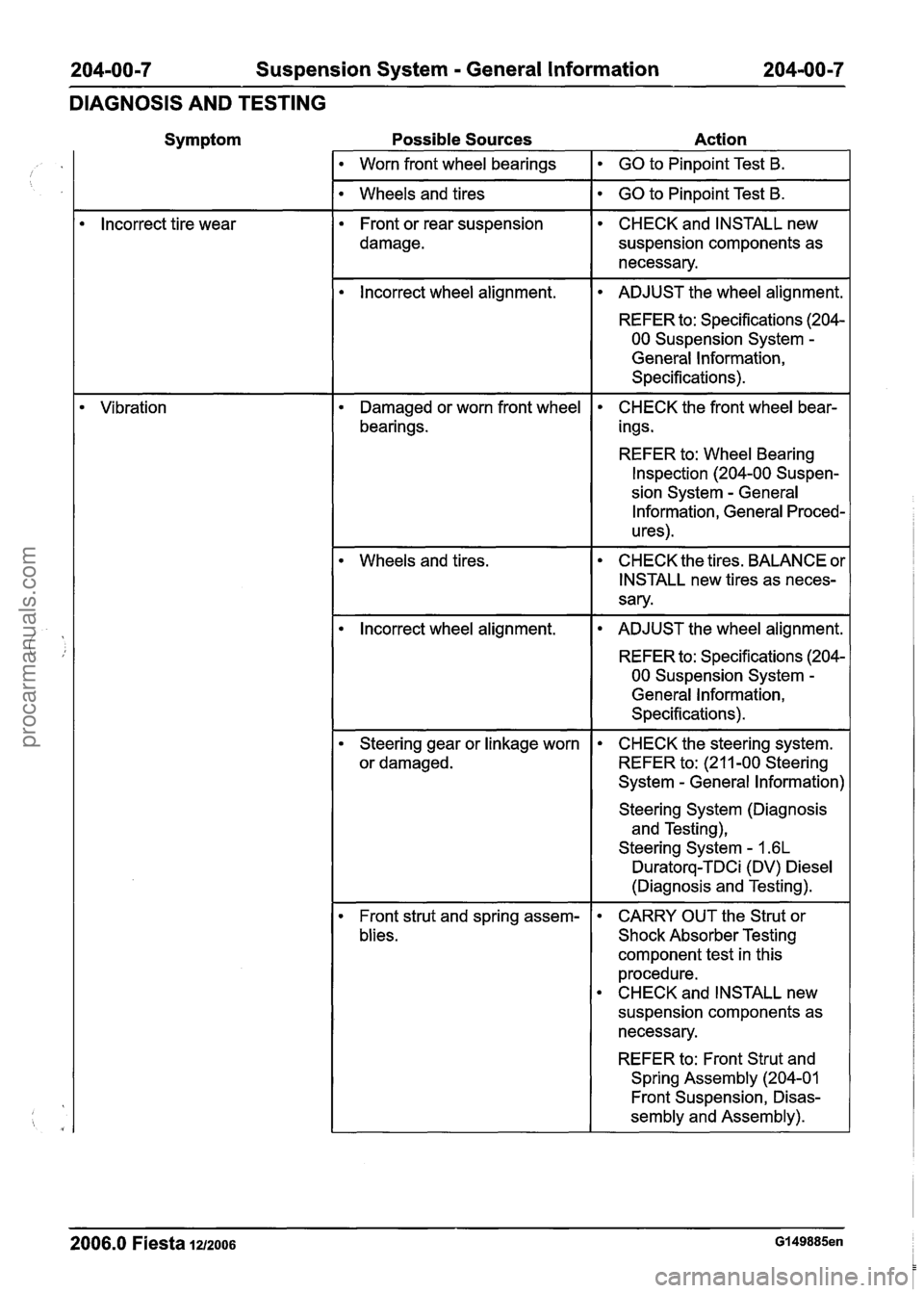
204-00-7 Suspension System - General Information 204-00-7
DIAGNOSIS AND TESTING
Possible Sources Action
1. Worn front wheel bearings I GO to Pinpoint Test B. I
I Wheels and tires I GO to Pinpoint Test B. I
Front or rear suspension
damage. CHECK and INSTALL new
suspension components as
necessary.
lncorrect wheel alignment. ADJUST the wheel alignment.
REFER to: Specifications (204-
00 Suspension System
-
General Information,
Specifications).
Damaged or worn front wheel
bearings. CHECK
the front wheel bear-
ings.
REFER to: Wheel Bearing
Inspection (204-00 Suspen-
sion System
- General
Information, General Proced-
ures).
Wheels and tires. CHECK the tires. BALANCE or
INSTALL new tires as neces-
sary.
I Incorrect wheel alignment. I ADJUST the wheel alignment.
REFER to: Specifications (204-
00 Suspension System
-
General Information,
Specifications).
Steering gear or linkage worn
or damaged. CHECK the steering system.
REFER to: (2
11 -00 Steering
System
- General Information)
Steering System (Diagnosis
and Testing),
Steering System
- I .6L
Duratorq-TDCi (DV) Diesel
(Diagnosis and Testing).
Front strut and spring assem-
1 blies. CARRY OUT
the Strut or
Shock Absorber Testing
component test in this
procedure.
CHECK and INSTALL new
suspension components as
necessary.
REFER to: Front Strut and
Spring Assembly (204-01
Front Suspension, Disas-
sembly and Assembly).
2006.0 Fiesta 1212006 G149885en
procarmanuals.com
Page 95 of 1226
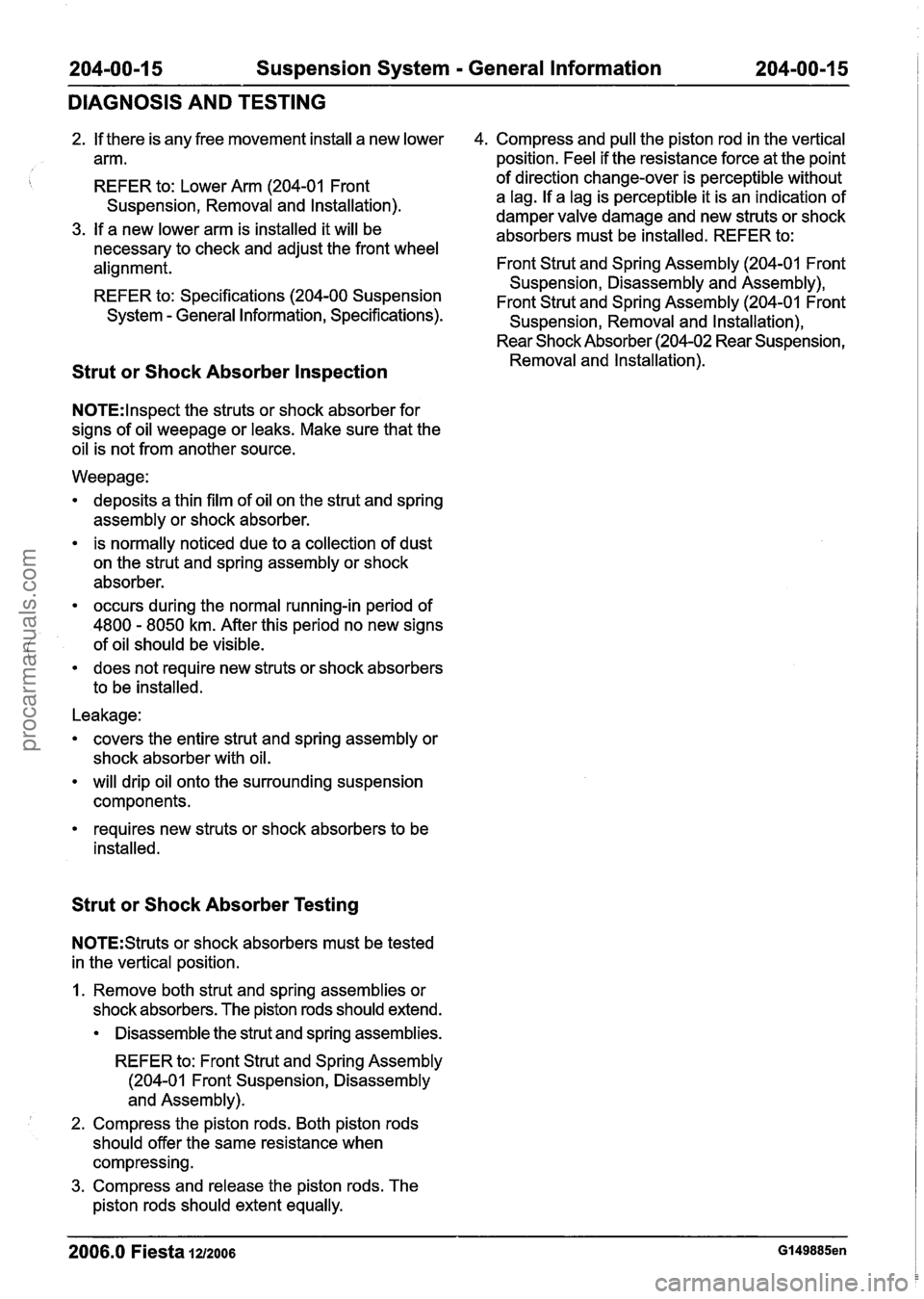
204-00-1 5 Suspension System - General Information 204-00-1 5 1
DIAGNOSIS AND TESTING
2. If there is any free movement install a new lower 4. Compress and pull the piston rod in the vertical
arm. position. Feel if the resistance force at the point
REFER to: Lower Arm (204-01 Front
Suspension, Removal and Installation).
3. If a new lower arm is installed it will be
necessary to check and adjust the front wheel
alignment.
REFER to: Specifications (204-00 Suspension
System
- General Information, Specifications). of direction change-over
is perceptible without
a lag. If a lag is perceptible it is an indication of
damper valve damage and new struts or shock
absorbers must be installed. REFER to:
Front Strut and Spring Assembly (204-01 Front
Suspension, Disassembly and Assembly),
Front Strut and Spring Assembly (204-01 Front
Suspension, Removal and Installation),
Rear Shock Absorber (204-02 Rear Suspension,
Removal and Installation).
Strut or Shock Absorber Inspection
N0TE:lnspect the struts or shock absorber for
signs of oil
weepage or leaks. Make sure that the
oil is not from another source.
Weepage:
deposits a thin film of oil on the strut and spring
assembly or shock absorber.
is normally noticed due to a collection of dust
on the strut and spring assembly or shock
absorber.
occurs during the normal running-in period of
4800
- 8050 km. After this period no new signs
of oil should be visible.
does not require new struts or shock absorbers
to be installed.
Leakage:
covers the entire strut and spring assembly or
shock absorber with oil.
will drip oil onto the surrounding suspension
components.
requires new struts or shock absorbers to be
installed.
Strut or Shock Absorber Testing
N0TE:Struts or shock absorbers must be tested
in the vertical position.
I. Remove both strut and spring assemblies or
shock absorbers. The piston rods should extend.
Disassemble the strut and spring assemblies.
REFER to: Front Strut and Spring Assembly
(204-01 Front Suspension, Disassembly
and Assembly).
2. Compress the piston rods. Both piston rods
should offer the same resistance when
compressing.
3. Compress and release the piston rods. The
piston rods should extent equally.
2006.0 Fiesta 1212006 Gl49885en
procarmanuals.com
Page 107 of 1226
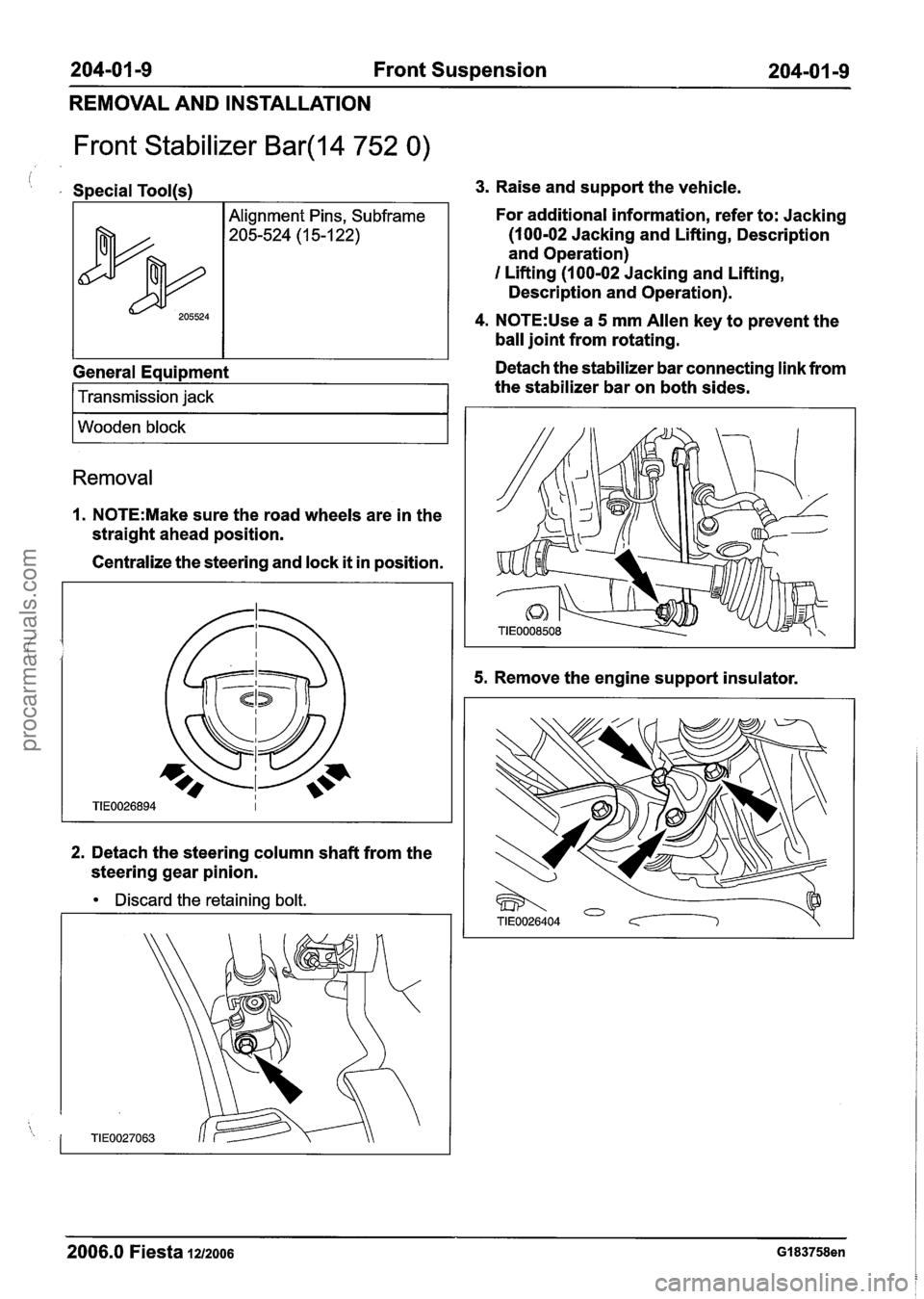
204-01 -9 Front Suspension 204-0 I -9
REMOVAL AND INSTALLATION
Front Stabilizer Bar(l4 752 0)
i , Special Tool(s1
General Equipment
205524
I Transmission jack 1
Alignment Pins, Subframe
205-524 (1 5-1 22)
I Wooden block I
Removal
1. N0TE:Make sure the road wheels are in the
straight ahead position.
Centralize the steering and lock
it in position.
2. Detach the steering column shaft from the
steering gear pinion.
Discard the retaining bolt.
3. Raise and support the vehicle.
For additional information, refer to: Jacking
(100-02 Jacking and Lifting, Description
and Operation)
I Lifting (1 00-02 Jacking and Lifting,
Description and Operation).
4. N0TE:Use a 5 mm Allen key to prevent the
ball joint from rotating.
Detach the stabilizer bar connecting link from
the stabilizer bar on both sides.
5. Remove the engine support insulator.
2006.0 Fiesta 1212006 GI 83758en
procarmanuals.com
Page 147 of 1226
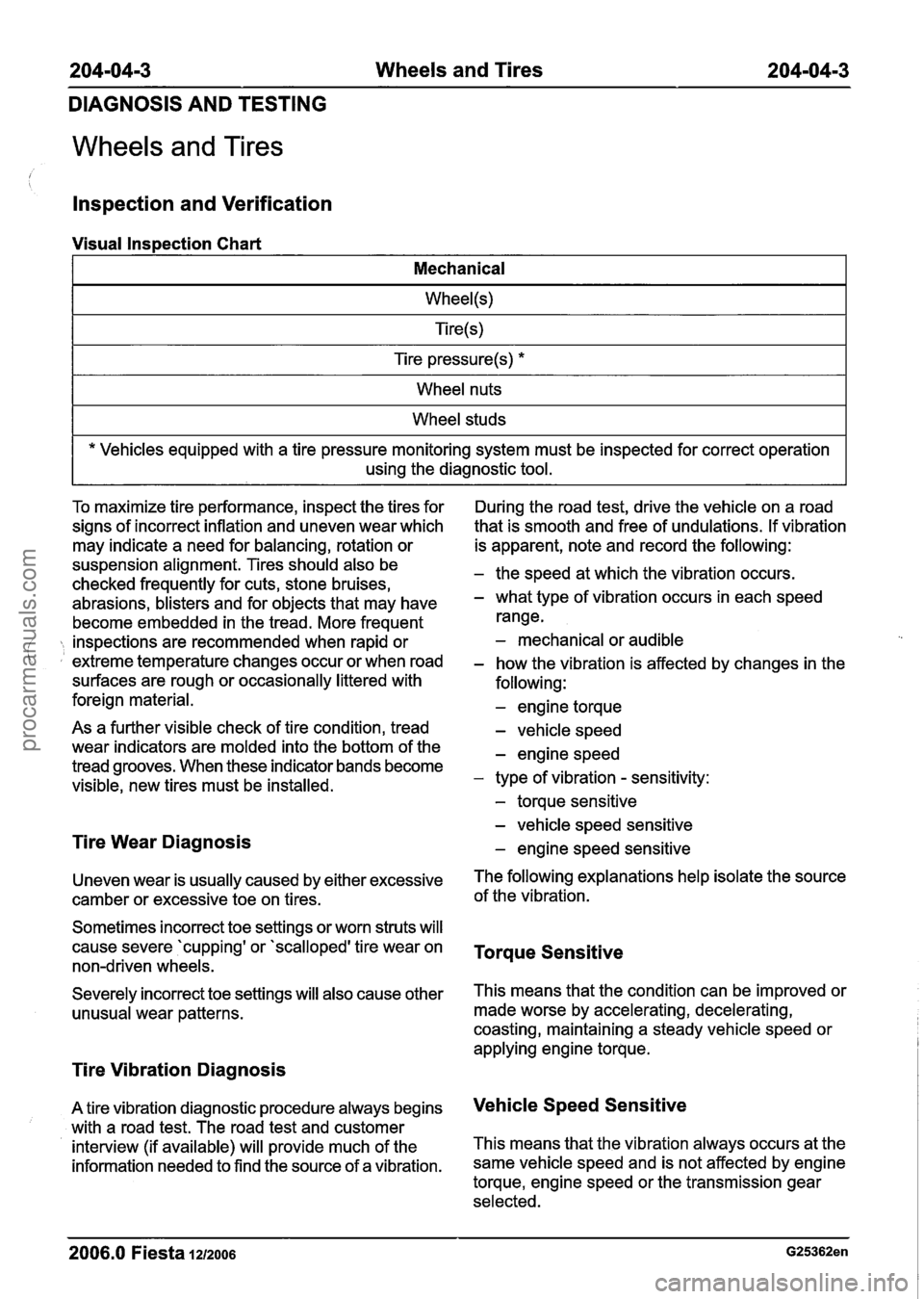
204-04-3 Wheels and Tires 204-04-3
DIAGNOSIS AND TESTING
Wheels and Tires
lnspection and Verification
Visual Inspection Chart
I Mechanical I
I Tire pressure(s) * I
I Wheel nuts I
I Wheel studs I
* Vehicles equipped with a tire pressure monitoring system must be inspected for correct operation
using the diagnostic tool.
To maximize tire performance, inspect the tires for
signs of incorrect inflation and uneven wear which
may indicate a need for balancing, rotation or
suspension alignment. Tires should also be
checked frequently for cuts, stone bruises,
abrasions, blisters and for objects that may have
become embedded in the tread. More frequent
inspections are recommended when rapid or ( extreme temperature changes occur or when road
surfaces are rough or occasionally littered with
foreign material.
As a further visible check of tire condition, tread
wear indicators are molded into the bottom of the
tread grooves. When these indicator bands become
visible, new tires must be installed.
Tire Wear Diagnosis
Uneven wear is usually caused by either excessive
camber or excessive toe on tires.
Sometimes incorrect toe settings or worn struts will
cause severe 'cupping' or 'scalloped' tire wear on
non-driven wheels.
Severely incorrect toe settings will also cause other unusual wear patterns.
Tire Vibration Diagnosis
A tire vibration diagnostic procedure always begins
with a road test. The road test and customer
interview (if available) will provide much of the
information needed to find the source of a vibration. During
the road test, drive the vehicle on a road
that is smooth and free of undulations. If vibration
is apparent, note and record the following:
- the speed at which the vibration occurs.
- what type of vibration occurs in each speed
range.
- mechanical or audible
- how the vibration is affected by changes in the
following:
- engine torque
- vehicle speed
- engine speed
- type of vibration - sensitivity:
- torque sensitive
- vehicle speed sensitive
- engine speed sensitive
The following explanations help isolate the source
of the vibration.
Torque Sensitive
This means that the condition can be improved or
made worse by accelerating, decelerating,
coasting, maintaining a steady vehicle speed or
applying engine torque.
Vehicle Speed Sensitive
This means that the vibration always occurs at the
same vehicle speed and is not affected by engine
torque, engine speed or the transmission gear
selected.
2006.0 Fiesta 1212006
procarmanuals.com
Page 148 of 1226
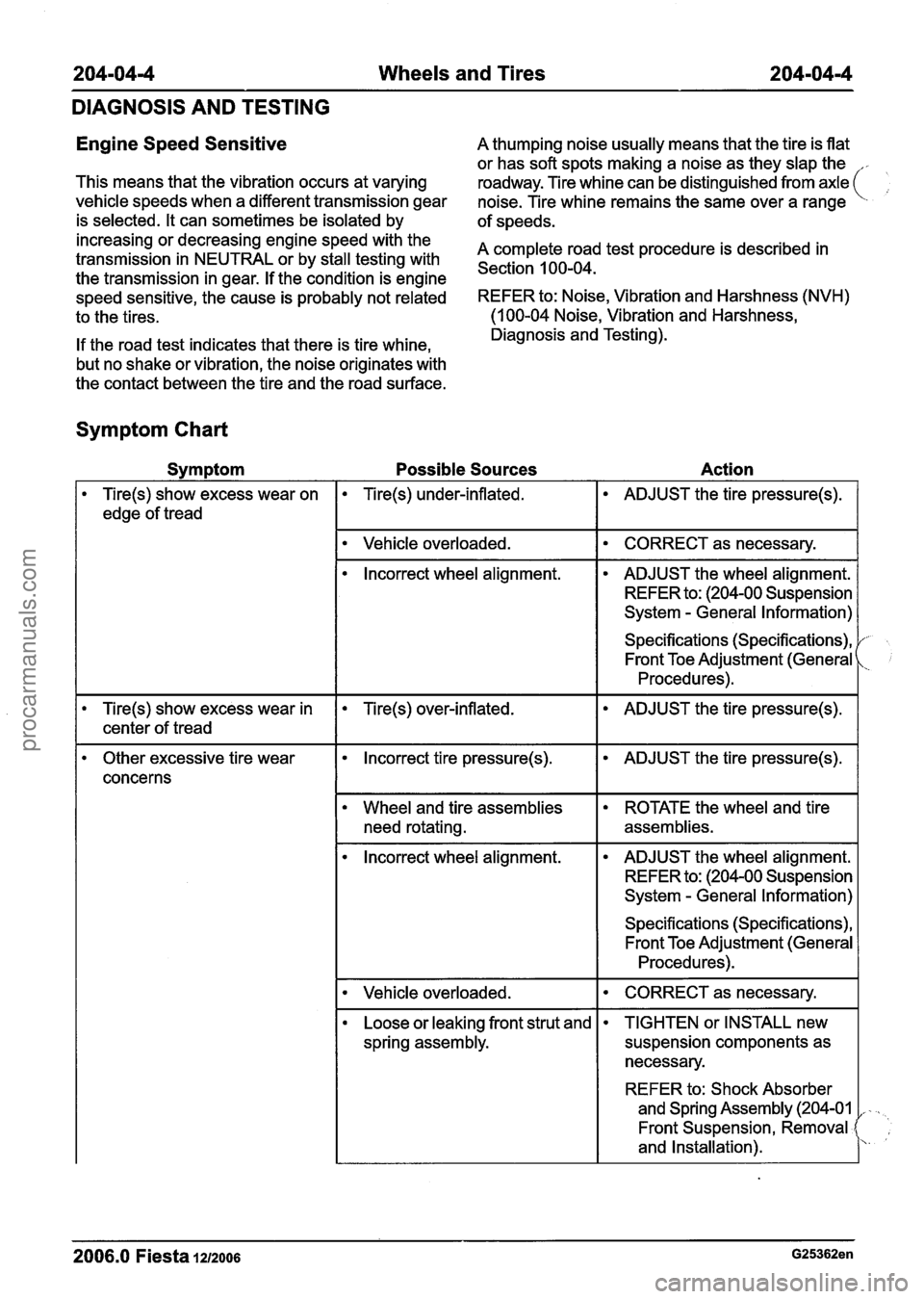
204-0414 Wheels and Tires 204-04-4
DIAGNOSIS AND TESTING
Engine Speed Sensitive A thumping noise usually means that the tire is flat
or has soft spots making a noise as they slap the
This means that the vibration occurs at varying
roadway. Tire whine can be distinguished from axle
vehicle speeds when a different transmission gear
noise. Tire whine remains the same over a range
is selected. It can sometimes be isolated by
of speeds.
increasing Or decreasing engine with the A complete road test procedure is described in transmission in NEUTRAL or by stall testing with Section the transmission in gear. If the condition is engine
speed sensitive, the-cause is probably not related
REFER to: Noise, Vibration and Harshness (NVH)
to the tires. (1
00-04 Noise, Vibration and Harshness,
If the road test indicates that there is tire whine, Diagnosis and
Testing).
but no shake or vibration, the noise originates with
the contact between the tire and the road surface.
Symptom Chart
Symptom Possible Sources Action
Tire(s) show excess wear on
edge of tread
I Vehicle overloaded. I CORRECT as necessary. I
Tire(s) under-inflated.
lncorrect wheel alignment. ADJUST the tire pressure(s).
ADJUST the wheel alignment.
REFER to: (204-00 Suspension
System
- General Information)
Specifications (Specifications), Front Toe Adjustment (General
Procedures).
Tire(s) show excess wear in Tire(s) over-inflated.
I I
ADJUST the tire pressure(s).
I center of tread
Other excessive tire wear Incorrect tire pressure(s).
concerns
need rotating.
ADJUST the tire pressure(s).
ROTATE the wheel and tire
assemblies.
lncorrect wheel alignment. ADJUST the wheel alignment.
REFER to: (204-00 Suspension
System
- General Information)
Specifications (Specifications), Front Toe Adjustment (General
Procedures).
I Vehicle overloaded.
Loose or leaking front strut and
spring assembly. CORRECT as necessary.
I
2006.0 Fiesta 1212006 G25362en
TIGHTEN
or INSTALL new
suspension components as
necessary.
REFER to: Shock Absorber
and Spring Assembly (204-01
,
Front Suspension, Removal
and Installation).
procarmanuals.com
Page 176 of 1226
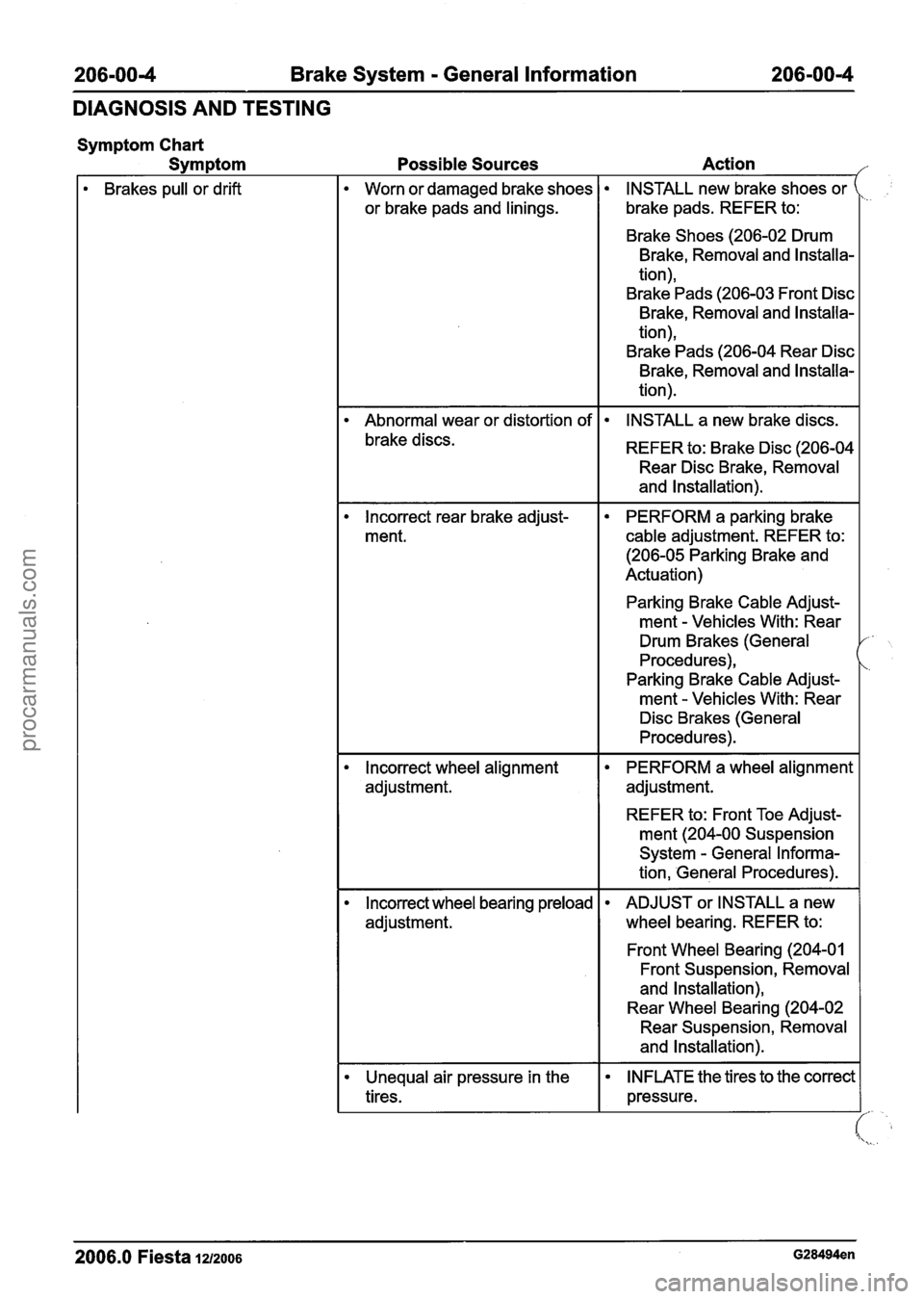
206-004 Brake System - General Information 206-00-4
DIAGNOSIS AND TESTING
Symptom Chart - -
Symptom
Brakes pull or drift
Possible Sources Action
Worn or damaged brake shoes
or brake pads and linings. INSTALL
new brake shoes or ,
brake pads. REFER to:
Brake Shoes (206-02 Drum
Brake, Removal and Installa-
tion),
Brake Pads (206-03 Front Disc
Brake, Removal and Installa-
tion),
Brake Pads (206-04 Rear Disc Brake, Removal and Installa-
tion).
Abnormal wear or distortion of
brake discs.
INSTALL a new brake discs.
REFER to: Brake Disc (206-04
Rear Disc Brake, Removal
and Installation).
lncorrect rear brake adjust-
ment. PERFORM
a parking brake
cable adjustment. REFER to:
(206-05 Parking Brake and
Actuation)
Parking Brake Cable Adjust-
ment
- Vehicles With: Rear
Drum Brakes (General
Procedures),
Parking Brake Cable Adjust-
ment
- Vehicles With: Rear
Disc Brakes (General
Procedures).
lncorrect wheel alignment
adjustment. PERFORM a
wheel alignment
adjustment.
REFER to: Front Toe Adjust-
ment (204-00 Suspension
System
- General Informa-
tion, General Procedures).
l ncorrect wheel bearing preload
adjustment. ADJUST or INSTALL a new
wheel bearing. REFER to:
Front Wheel Bearing (204-01 Front Suspension, Removal
and Installation),
Rear Wheel Bearing (204-02 Rear Suspension, Removal
and Installation).
2006.0 Fiesta 1212006 G28494en
Unequal air pressure in the
tires. INFLATE the tires to the correct
pressure.
procarmanuals.com
Page 195 of 1226
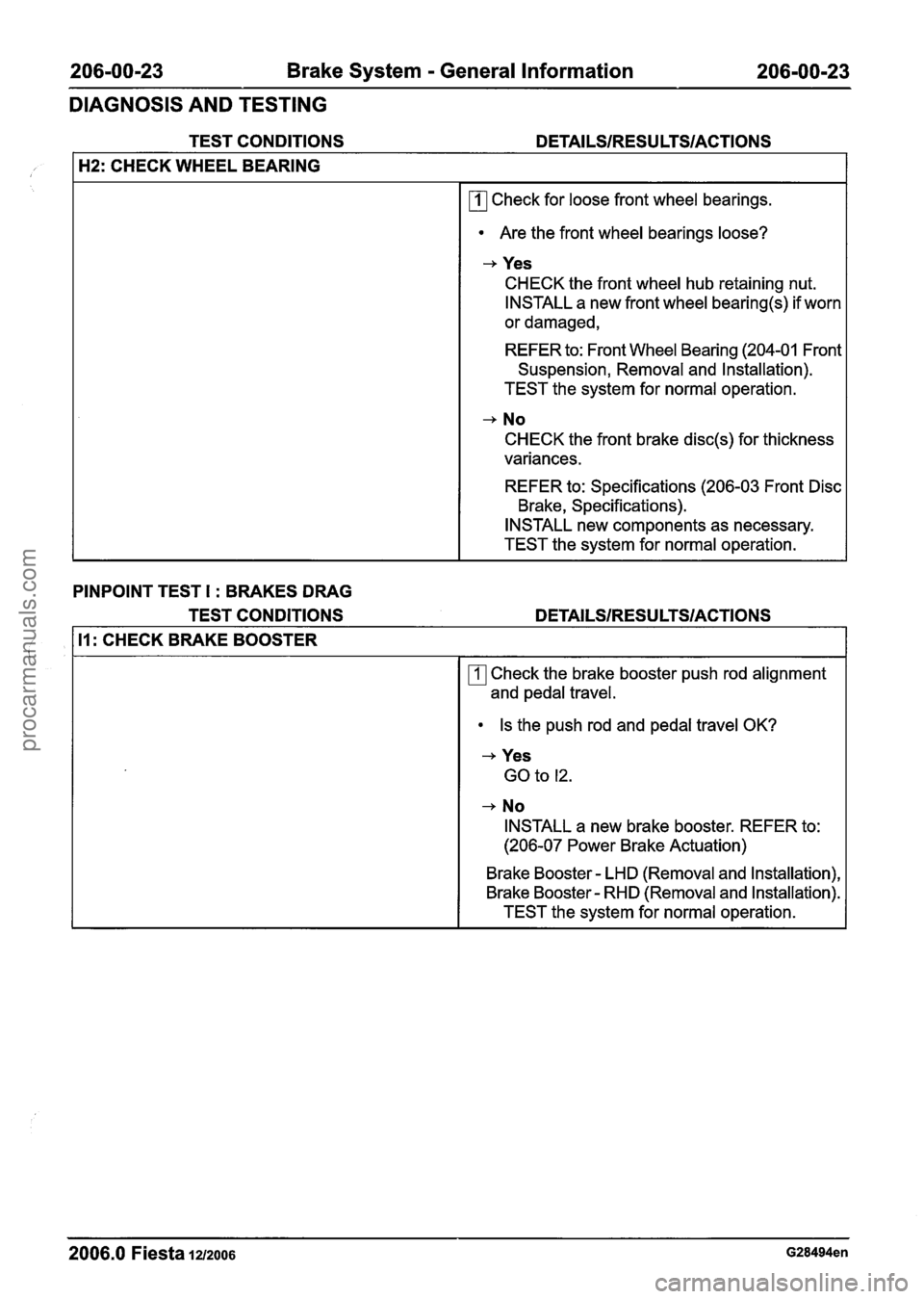
206-00-23 Brake System - General Information 206-00-23
DIAGNOSIS AND TESTING
TEST CONDITIONS DETAILSIRESULTSIACTIONS
H2: CHECK WHEEL BEARING
rn Check for loose front wheel bearings.
Are the front wheel bearings loose?
-, Yes
CHECK the front wheel hub retaining nut.
INSTALL a new front wheel
bearing(s) if worn
or damaged,
REFER to: Front Wheel Bearing (204-01 Front
Suspension, Removal and Installation).
TEST the system for normal operation.
-, No
CHECK the front brake disc(s) for thickness
variances.
REFER to: Specifications (206-03 Front Disc
Brake, Specifications).
INSTALL new components as necessary.
TEST the system for normal operation.
PINPOINT TEST I : BRAKES DRAG
TEST CONDITIONS
DETAILSIRESU LTSIACTIONS
11: CHECK BRAKE BOOSTER
rn Check the brake booster push rod alignment
and pedal travel.
Is the push rod and pedal travel OK?
-+ Yes
GO to 12.
+ No
INSTALL a new brake booster. REFER to:
(206-07 Power Brake Actuation)
Brake Booster
- LHD (Removal and Installation),
Brake Booster
- RHD (Removal and Installation).
TEST the system for normal operation.
2006.0 Fiesta 1212006 G28494en
procarmanuals.com